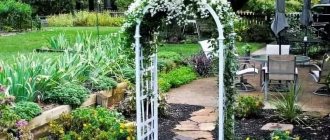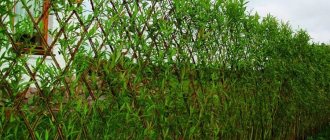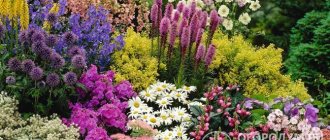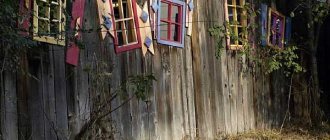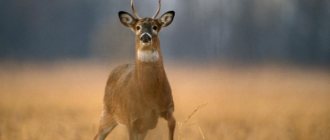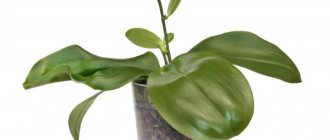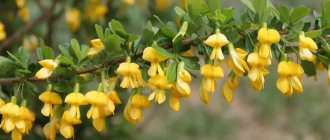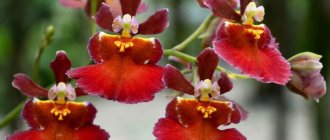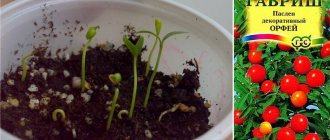A hedge gives the area a more well-groomed and noble appearance. Properly selected shrubs help protect the area from dust, dirt, prying eyes, and purify the air. Plants that are used as hedges are selected not only depending on personal tastes, but also taking into account specific climatic conditions.
Ideas for using hedges
Landscape designers use green spaces as low borders. It emphasizes the curves of paths and architectural objects, flower beds and fountains. Living decoration is also suitable for decorating a pond or playground. What is the best hedge to use as a border:
- cowberry;
- Thunberg barberry;
- boxwood;
- Lawson cypress;
- dwarf caragana.
A “border” of plants.
On a large area, plantings can be used to zone the space. Separate the recreation area from the garden or vegetable garden. Designers advise choosing shrubs with a height of up to a meter. This will avoid creating unnecessary shadow. Planted in parallel, symmetrically, wavy.
Standard rectangular shapes surprise no one. Shrubs for hedges can take a variety of shapes. Even a novice gardener can do cubes, arches, waves. Masters of their craft embody images of animals using garden shears. Such compositions require frequent maintenance.
Designer flower beds
Using plantings as a design accent is a great option. Colorful multi-level structures transform any area. Red-leaved boxwood and blue spruce are often combined. To maintain an attractive appearance, experts recommend choosing perennial plants of a contrasting shade.
If the area looks bland, then it is good to use flowering plants. Spiraea, currant and hawthorn bloom from several weeks to a month. By combining large plants with low borders, you can get compositions that bloom all year round.
Properly selected plants are the key to beautiful flower beds all year round
Eclecticism is trending not only on fashion catwalks. Hedging bushes are combined not only with sculptural compositions. The following solutions also apply:
- gabions;
- large stones;
- boulders;
- fences;
- wooden modules;
- brick pillars.
Green plants will help “restore” an old fence. Climbing or tall plants are useful for this purpose. The wire structure will allow you to create a hedge of clematis, hydrangea, honeysuckle, grapes and wisteria. Climbing roses are especially beautiful.
Path of roses
See also: Catalog of companies that specialize in landscaping work on sites.
Advantages and disadvantages of hedges
“Living” fencing has a number of positive and negative properties that should be taken into account before planning the creation of this type of green space.
Main advantages:
- a living fence can hold water in the ground. It protects the soil from drying by winds; the snow in such an area melts a little slower, so more moisture is absorbed by the ground;
- the fence protects those on the site from street dust and filters harmful exhausts produced by vehicles;
- crops and young plants are mechanically protected from the winds - their leaves suffer less from breakage of stems, leaves, blowing of flowers and fruits;
- in the hot season, such barriers prevent the rapid spread of fires in the fields if they occur locally;
- a living fence protects from cold winds and prevents snow drifts on the paths;
- livestock finds life-saving shade under it, protection from bad weather;
- Birds often settle here and destroy insect pests of agricultural vegetation;
- Woody and plant residues formed as a result of thinning the fence serve as fuel for the stove, fireplace, and are used for making crafts and various household needs.
But there are also negative sides:
- decorative hedges occupy a significant part of the usable area of the site, which could be used for growing vegetables;
- a high fence shades lower plantings and takes away some of the nutrients from the soil;
- inevitable problems arise with digging up the soil - near living fences, processing is carried out as carefully as possible so as not to damage the roots;
- if the snow in such places is not removed on time, part of the crop gets wet and rots;
- additional routes are required to remove crops and waste from the site;
- in living fences, in addition to useful ones, harmful birds settle in, which destroy crops, damage crops, as well as rodents;
- proper crop rotation is also problematic.
A well-thought-out planting geometry will save the owner from many problematic issues, emphasizing the beauty of the existing landscape.
TOP fast-growing shrubs for creating a hedge
In landscape design, a “fence” of green spaces is usually divided into two types: formalized and unformed. The latter is used extremely rarely, as it gives the site a neglected appearance. Fast-growing hedge shrubs will transform your landscape in a short time.
- Dogwood , with proper care, reaches 3-4 meters in height. It blooms from March to April, then blooms leaves and fruits. A well-lit area is suitable for growing. When buying an annual plant, you need to understand that dogwood grows slowly, and a two-year-old seedling grows more actively.
Dogwood hedge
- The bladderwort is unpretentious in care. It is important that the water at the roots does not stagnate, otherwise the plant will die. It reaches four meters in height, but dwarf shrubs up to a meter are suitable for creating a neat hedge. Over the course of a year, he gains 35-38 cm in height. Maintains an attractive appearance throughout the season.
Bladderwort hedge
- Snowberry belongs to the genus Honeysuckle. Bluish-green leaves, white flowers with a pink tint are complemented by berries. The hedge looks very unusual and elegant. This shrub is suitable for plantings no more than 125-130 cm in height.
Advice! The snowberry is unsuitable for a formalized hedge with clear edges. For this purpose it is better to choose another option.
- Hawthorn is simply created for a hedge. It grows quickly, lives for three hundred years and is unpretentious to living conditions. At the gardener’s request, you can create either a sparse “wall” or a dense dense hedge. Designers advise planting exclusively in a checkerboard pattern.
Hawthorn hedge
Only three-year-old plants are suitable for planting. Two years after planting, the bush is heavily pruned, leaving 20 cm branches. This will lead to an increase in the density of the future hedge.
Functions of a hedge
A “living” fence is not just a beautiful, multifunctional fence, but also an original element of landscape design, designed to harmoniously complement the existing architectural ensemble. Such plantings have been used by humans for many centuries, and methods of caring for them are constantly being improved.
A living fence not only looks good, being a source of pride for the owner, but also perfectly purifies the air from toxic substances that are inevitably present in the air near large cities, provides shade, which is important for both humans and animals, prevents erosion, soil erosion, its overdrying. Climbing species are allowed to “crawl” along an old shabby fence, providing original camouflage and giving an aesthetic appearance.
Previously, fruit plants used for food were planted as a living barrier, but the yield with excessively dense plantings was very small.
TOP evergreen shrubs for hedges
If you need a fast-growing perennial evergreen hedge, then thuja is an ideal option. There are more than a hundred different species, among which are smaragd and brabant .
Annual growth is up to 30 cm. You can create a rarer evergreen “fence” or a dense one. In the latter case, thuja is planted every 50cm.
Dense fence made of thuja
Boxwood grows more slowly, barely reaching 20 cm annually. But gardeners love the plant for its ease of care and resistance to different weather conditions. The plant allows you to create a dense hedge up to a meter high.
Advice! The plant is thermophilic. Before the onset of frost, it should be covered.
Juniper is a favorite of landscape designers. The plant likes to be in the shade and is resistant to frost and precipitation. A fast-growing perennial juniper hedge does not require frequent watering. Planted at a distance of 60 cm. Spreading varieties are preferable for decorating borders.
Juniper hedge
Privet is considered an evergreen plant suitable for creating a hedge . Glossy elongated leaves with snow-white flowers. Closer to autumn, small berries of a characteristic blue color appear. For a decorated green “fence” it is suitable only with regular pruning over a long period of time. More often used for the unformed version.
Privet does not like careful design
Yew is a berry version of pine needles. It is odorless due to the absence of emitted resin. Suitable in landscape design for creating hedges. It differs in that:
- easy to care for;
- holds its shape for a long time;
- withstands heavy pruning;
- Any shape can be realized from it.
A hedge made of yew bushes is suitable for decorating a summer cottage and the territory of a hotel, restaurant, or park. Low and dense green “walls” look neat and tidy. A strong root system does not require frequent loosening of the soil and special fertilizers. Resistant to temperature changes. Yew does not grow as fast as other conifers. But the shape lasts for a very long time.
Yew hedge
Plant selection: fast-growing trees, shrubs for a green fence
Many types of fast-growing trees and shrubs are used to create hedges, such as thuja, barberry, boxwood, blackthorn, dwarf spruce, honeysuckle, heather, rowan, lilac, hornbeam, serviceberry, ivy, mulberry and many others.
Barberry
Barberry makes a beautiful, reliable, thick and prickly wall that even a cat cannot crawl through. Thanks to its dense, deep root system, it is often used to strengthen slopes. Barberry is actively growing, so it is important to remove all excess seedlings immediately after detection; they are often damaged by powdery mildew and rust, which is why disease prevention is required. The main varieties used: Amur, common, Thunberg barberry. The fruits of most species are edible.
Periwinkle
Periwinkle is a climbing evergreen subshrub. With its help, “green walls” more than one and a half meters high are obtained. The plant is distinguished by its amazing vitality - it is not afraid of frost, feels great even on soils poor in nutrients, tolerates the dry season well, and can grow both in sunny places and in the shade. To create a hedge, you will need trellises; in the first year of life, the seedlings should be covered for the winter so that the young roots do not freeze.
Euonymus
Euonymus has many varieties, but the climbing varieties are the most commonly used. The plant is poisonous, which should be taken into account if there are small children in the family. It is advisable to use rubber gloves during planting. Variegated types of euonymus are planted in the sunny side, while varieties with white and yellow foliage are planted in the shade, as the leaves can fade. Seedlings are rooted, covered with film; supports will be required to create a fence; pruning is done in late winter - early spring. Popular varieties: fortune euonymus - harlequin, blondie.
Privet
A living fence made from privet or “wolfberry” combines beauty and functionality, being a close relative of lilac. It grows quickly, especially after pruning, and forms impenetrable thickets up to three meters high. Privet is often used to form not only walls, but also entire sculptural compositions of the most bizarre shapes. Plants are planted as close to each other as possible, preferably in a place well lit from all sides, on soils with good drainage. Before planting, manure and other organic matter are placed in the trench.
Hawthorn
Hawthorn is a deciduous shrub with many trunks, an excellent honey plant with edible fruits. It is unpretentious and tolerates frost, prolonged drought and shade. Hawthorn wood is very plastic, which allows you to form all sorts of shapes from its branches. In summer, the plant is covered with green leaves, which by autumn take on a red-orange hue; the fruits of many species are used as food and serve as raw materials for medicines. Common types: common, black, monopistillate, Siberian.
Heather
Heather is a low melliferous shrub with narrow leaves of green, silver, and red-orange colors. The plant blooms in early August, but the flowers themselves remain dry until winter. Heather can grow on the poorest soils, but for lush flowering and maintaining high decorative value, it is advisable to fertilize the soil. This plant is not tall, therefore it is used only for creating borders; it is recommended to plant it in early spring; it can be grown by seedlings, layering, dividing the rhizome or from seeds.
Hydrangea
Hydrangea is suitable for forming medium and low living walls. The plant prefers fertile soils and has large leaves and inflorescences. Tree hydrangea is planted at the age of about two years; it requires regular watering, especially during dry periods, and frequent fertilization during budding. Pruning is also done several times during the summer, and once every two to three years - thinning, removing the oldest shoots. Dried inflorescences can be cut off or left as a winter garden decoration.
Deytsia
Deutzia is a profusely flowering but practically odorless plant. The fence from it looks very elegant, but high - up to three to four meters. Deytsia is unpretentious - it tolerates polluted city air well, but abundant flowering will occur only in loose, nutritious soil, in a well-lit place. The plant is afraid of cold, but quickly recovers when partially frozen. All varieties are suitable for living walls, but especially Deutzia Lemoine, rough, graceful, less often - Amur, small-flowered. Planting is done in the spring, planting each plant in a separate hole.
Spruce
Live spruce is a very popular evergreen plant for garden hedges. It varies in height - both low-growing varieties and ordinary ones are used. They are usually planted on the north side to protect the garden from cold winds, practically without shading it. Spruce grows slowly, but always looks fresh. Its shades are green, blue, golden yellow; if you plant such plants in a certain order, you will get an amazingly beautiful composition. A spruce fence protects well from prying eyes; with high-quality, timely pruning, it looks aesthetically pleasing all year round.
Irga
Irga is a plant belonging to the apple subfamily, but its fruits are berries. The roots of the serviceberry penetrate deeply into the soil, so it is not afraid of any drought. Some species have significant frost resistance, bloom profusely and very beautifully. Serviceberry berries have a cinnamon flavor, and the plant itself, due to its root shoots, forms a dense wall in the second or third year. Planting is done in late autumn or spring; at first, abundant watering is required, and later - garter, since the branches often bend under the weight of ripe berries.
Honeysuckle Honeysuckle
Honeysuckle of the honeysuckle variety withstands frosts well, reaching more than five meters in height, and is an abundant honey plant. The plant thrives in moist soils, sunny places, has dense foliage and tasty berries. Seedlings are first grown at home in flowerpots, and in spring or autumn they are planted in open ground. When planting, you should install strong supports for the fence - they are made of wood or metal; the hedge can also rest on a regular fence. A finished hedge requires painstaking care - regular trimming to shape, watering, and fertilizing.
Willow
A living willow fence looks very elegant; the tree grows quickly, forming a full-fledged high wall in three years. Willow is frost-resistant, there are about 600 species, but the most commonly used are holly, silver, Babylon, purple, and Hakuro Nishiki. Planting is carried out from early spring to late autumn, sunny places are preferred, fertilizer is not necessary, but abundant watering in the first year of life is important. The seedlings are placed at an angle of 45 degrees and secured with supports and rods. It is recommended to intertwine, tying crosswise, a year after planting.
Campsis grandiflora
Campsis or trumpet flower is a perennial flowering deciduous vine. The plant is unpretentious, frost-resistant, but loves warmth and light, blooms from June to the end of September. Campsis grows extremely quickly, so it is important to trim it in time, direct the shoots in the right direction, remove old branches, freeing up space for new ones. The plant is often used in mixed plantings, planting other low-growing perennials in the foreground that cover the base of the vines. In the first year the vine grows by more than a meter.
cotoneaster
Cotoneaster is divided into two varieties: deciduous and evergreen. The most commonly grown cotoneaster is brilliant - it is planted in partial shade, on sandy soil in which there is no stagnation of moisture. The plant is used to create walls 1-1.8 meters high, borders and islands up to 60-80 cm tall. It is recommended to plant cotoneaster in a maximum of one or two rows. Planting specimens with bare roots is done in the spring, before buds open or after the leaves fall, just before frost. Plants with a closed root system can be planted from early spring to late summer.
Lawson's cypress
Lawson's cypress belongs to the cypress family, has scaly needles, cascading shoots, a cone-shaped crown, and a developed root system. The evergreen plant adapts well to unfavorable urban conditions and poor soils, but during severe frosts, young shoots often freeze, so in the middle zone it should be covered with spruce branches. It is recommended to water the cypress tree frequently, abundantly, loosen the soil, and prune it on time. The plant is suitable for high walls and mixed plantings.
Cupressociparis Leyland
Leyland's cupressociparis has an evergreen cone-shaped crown with drooping shoots. The plant can reach more than 27 meters in height, and the crown can grow up to five meters wide. Seedlings are grown in flowerpots, and when their roots have developed sufficiently, they are planted in open ground. Cupressociparis grows well in the shade; young trees require frequent watering; older trees have enough rain. Over the course of a season, such a hedge adds more than a meter in height, so pruning is necessary.
Lavrovishnya
Cherry laurel makes very beautiful barriers - it looks similar to ficus and laurel. All species, except the medicinal one, grow extremely slowly, which is why the latter is used often. The plant is highly resistant to frost and shade, but requires a lot of water, and in the long-term absence of it it stops blooming and producing fruit. The first pruning is done at the end of summer, in the second year of planting, and then twice a year. Some varieties produce edible fruits and are practically not damaged by parasites or diseases. Cherry laurel is not only cut, but also bent and wrapped around supports and mesh.
Cinquefoil shrub
Cinquefoil shrub or “Kuril tea” is suitable not only for creating garden decorations, but also for brewing tea infusion. The plant is very tenacious, unpretentious, frost-resistant, up to one and a half meters high. If the bush is trimmed correctly, it will remain very decorative all year round. Popular varieties: Kobold, Goldfinger, Daydown, Princess. The plant prefers light, fertile soil; planting in the ground occurs when the seedlings are two years old; the soil surface is mulched with sawdust. Sanitary pruning is carried out in the spring.
Mahonia
Mahonia forms a low, loose fence, blooms beautifully, producing many tasty berries, and is a fragrant honey plant. Its leaves are green in summer and turn reddish-burgundy in winter. The shrub grows slowly, is unpretentious, frost-resistant, drought-resistant, and is not afraid of insect pests. In hedges it is most often combined with taller or shorter plants. It is preferable to plant in the shade; pruning is done in the spring, but not necessarily annually. Varieties: Japanese, holly, creeping.
Juniper
Evergreen juniper creates luxurious screens, bringing a true forest scent to the site. It is great for trimmed hedges, pairing well with deciduous trees. The most common types are: Chinese, scaly, Cossack, ordinary, Virginia. Different species grow from one and a half to 25 meters in height, their needles are green or bluish-blue. Most often, juniper is used to decorate large areas; it is unpretentious, but excessive stagnation of water can destroy the seedling. Planting is done in spring or autumn.
Holly
Holly produces a thorny, impenetrable, evergreen structure. The plant has dark shiny leaves, beautiful berries, and grows well in partial shade and sun. Planting is carried out in April or October; the hedge reaches its “adult” size in the fourth or fifth year of life. Most holly varieties are not suitable for extremely cold regions as they freeze easily. This type of living fence grows slowly, is damaged by flies, and must be trimmed once a year.
Balsam fir
The plant has a cone-shaped shape, soft needles with a pleasant aroma, and without pruning it can reach 23 meters or more in height. The hedge is formed from seedlings at least five to seven years old, preferably in April or September. The ground around the young trunk is generously sprinkled with sawdust and covered with spruce branches, since fir trees often freeze out in the first year after planting. It is better to plant in partial shade, choosing well-drained, fertilized soil, preferably near any bodies of water, but balsam fir does not tolerate stagnant water.
Garden ivy
A garden ivy fence is the most unpretentious design; even a novice gardener can grow it without any problems. The plant requires shelter in severe frosts and is adversely affected by winds. Planting is done in spring, preferably at higher elevations. The first year the ivy grows slowly, after which it grows a little faster. Frequent watering of ivy is not necessary - once a week is enough in hot periods; in rainier periods, you don’t need to water it at all. Ivy is convenient for decorating ugly garden buildings - fences, sheds, gazebos, etc.
Bladderwort
The most common variety is Viburnum foliage. This is a deciduous shrub up to three meters high, it is lush, very voluminous, has jagged leaves and “fluffy” fragrant inflorescences. Flowering and fruiting begin in plants older than four years. To ensure uniform leaf color, the vesicle is planted in sunny areas, away from fruit trees. Light, loose, well-drained soil is preferred; planting occurs in May. The plant is well adapted to the polluted air of large cities and filters it efficiently.
Rowan
Weeping chokeberry is used to create hedges. The plant is unpretentious, tolerates frost and drought well, its berries are edible. Rowan is propagated by cuttings, planted in spring in a well-lit place. Shearing is done two or more times in the first year, less frequently in subsequent years; it will take at least three to four years to form a fence. Before planting, it is advisable to fertilize the soil well, and fix the proposed contours of the future fence with a frame of sticks so that the shape is correct.
Lilac
Lilac is a universal option for creating living fences; it grows quickly in spring and summer, decorating the garden with white, pink, lilac, blue or violet flower clusters. The soil for lilacs is preferably well-drained; dwarf varieties are planted densely, larger ones - a little less often. The older the plant, the more viable it is - seedlings older than two years are purchased for planting. The first cutting is done two years after planting; this is done in early spring or after flowering. The soil around young specimens is sprinkled with sawdust to prevent the roots from freezing.
Snowberry
Snowberry is an unpretentious plant that has small white inedible berries hanging on the branches even in winter. Some species have red or black berries, but in the middle zone they are rare. Snowberry is recommended as a non-formable hedge, reaching a height of 1.6 m. It is often used in mixed plantings with mountain ash and roses. Planting is done in pots, since in open ground you will have to wait a long time for seedlings; in three years the plant reaches a height of one meter. Any soil, even calcareous, rocky soil, is suitable for the snowberry plant.
Spirea
There are about 90 different species of spirea; it blooms beautifully in spring without causing much trouble. The height of the finished fence is approximately 1.5 meters, it is dense and impassable for most animals. Any soil is acceptable for spirea, and drooping varieties do not even need pruning. There are also species that retain brightly colored foliage all year round. Popular types: Japanese, arguta, frobeli, bumald, average meadowsweet. It is recommended to lay the fence in October, in turf-peat soil; initially, abundant watering is required.
Boxwood
Boxwood or buxus is suitable for both free-growing fences and strict geometric shapes. It is easy to care for and can live up to 500 years. Frost-resistant species have green foliage, heat-loving species have variegated foliage. Specimens aged 3-7 years are suitable for planting in the ground; they are planted in a trench from the beginning of May to October, a maximum of a month before the onset of cold weather. Watering is necessary only during dry periods; cutting is done from spring to late autumn every 5-6 weeks. To obtain a rectangular fence, a wooden frame is required. It is important to know that all parts of boxwood are very poisonous, so children should not be allowed near it.
Thuja Brabant and Smaragd
Thuja is an evergreen tree actively used in landscape design. An impenetrable high fence made from it will perfectly protect against dust, foreign intrusions and excessive noise. Low-growing varieties are used for arranging borders. Thuja Brabant becomes brownish-brown in the winter, but at the same time retains the opacity of the hedge; over the course of a season, the tree adds up to 40 cm in height. The recommended age of seedlings for forming a hedge is over three years. Thuja Smaragd is green all year round, has a cone-shaped shape, but grows slowly. The fence made from it has a jagged top edge, which makes it even more difficult for unwanted penetration into the site. Young plants need abundant watering; older plants should not be allowed to dry out.
Forsythia
A hedge is formed from it in the fall; forsythia is very frost-resistant, blooms dazzling yellow, much earlier than others, before the first leaves appear. Forsythia prefers sunny areas where there are no strong winds or drafts. To create fences, varieties with the densest crown are selected. The plant looks good in mixed plantings; for lush flowering, it is fertilized twice a year. Watering is necessary in particularly dry seasons, pruning as necessary, but frozen, old branches must be cut off.
Chubushnik
Mock orange or garden jasmine is an incredibly fragrant plant; during flowering it emits a sweetish, intoxicating smell. Mock orange fences are graceful but lush, reaching 2.7 meters, with white-cream flowers. It is recommended to plant in sunny places with fertile soil, which should not be waterlogged. The formation of a planting is possible from two to three year old seedlings or cuttings, in autumn or spring. Anti-aging pruning is necessary every two years - then the flowering will be as lush as possible; thinning and annual fertilizing before the start of the growing season are necessary in the spring.
Mulberry
Of all the types of mulberry, white or black are most often used to create living walls, but there are about 18 species in total. It is resistant to cold, can live up to 200 years, has a spreading crown, incredibly tasty berries of white or black-purple color. Planting is preferable on well-drained loamy soils, preferably on the south side; the soil must be mulched so that the roots do not freeze. Sanitary pruning is done in winter, shaping is done on one and a half meter trunks. For abundant fruiting, annual fertilizer is necessary.
Rose hip
The rose hip hedge is very thorny, smells delicious during the flowering period, and then produces healthy, edible fruits. Designers often use “wild” rosehip - it is more unpretentious. Popular varieties: wrinkled, gray, Scottish rose, fragrant. Planting is formed from three-year-old seedlings with developed roots, but the use of cuttings is also acceptable. To prevent the root system from growing throughout the entire area, it is limited to pieces of slate dug to a depth of 50-60 cm. Young specimens are watered once every four days, adults - only in drought, fertilizer is applied every spring.
Shrubs that do not require regular trimming
It is convenient to use plants that do not need to be constantly trimmed to maintain an attractive shape. What is the best material to make a hedge from:
- kalmia;
- Spiraea Wangutta;
- caragana bush.
Kalmia bushes take root in loose soil. The plant cannot be called unpretentious. If water stagnates, the root system will quickly rot. Does not grow more than one and a half meters. The evergreen plant is distinguished by its unusual bright flowering in late spring.
Spiraea Vangutta is a large plant. Requires a lot of space, and therefore is not suitable for a small area. Beautiful bluish leaves, white flowers. The crown grows up to two meters in diameter.
Hedge Spirea Vangutta
Shrubby caragana takes root in areas with uneven surfaces. Differs in the shape of the leaves. The golden-hued flowers highlight the deep green of the foliage. It is easy to care for; caragana is resistant to temperature changes and tolerates heat and frost.
A bright yellow hedge will be made from forsythia . An amazing plant, which is one of the first to become covered with inflorescences and pleases its owners for more than a month. It consists of thin branches that allow you to give the bush any shape. A sunny, draft-free place is suitable for planting. You will have to wrap the plant in winter and provide plenty of watering in summer. The shrub is capricious to temperature changes.
Severe frosts will destroy the plant, and it will be impossible to restore the fence. Fertilize with mineral fertilizers in early or mid-spring, and add organic mixtures in the fall. Haircuts are done rarely and carefully. If you cut off all the sprouts that appear, the forsythia may not bloom in the spring.
Advice! It is better to trim forsythia after the end of the flowering period.
"Wall" of forsythia
Features of the design of a site with a hedge
The landing site is chosen to be the outer perimeter of the site or a small area that needs to be made as private as possible.
The height of the structure can be very different:
- border - planting less than 0.5 meters high;
- low – 0.6-1.0 meters;
- average – 1.1-1.5 meters;
- high – over 1.6 meters.
The most popular are combined fences, which are created using plants of several species that differ significantly in height.
There are also several types of plantings:
- evergreen - look beautiful all year round, practically unchanged;
- deciduous - lose their leaves in autumn, look good in summer;
- blooming - they have maximum decorative effect during the flowering period;
- curly - capable of weaving, clinging to any support.
According to their structure, hedges are divided into:
- monogeneous - consist of vegetation of one type;
- trellis - consist of trees growing in a row, the branches of which are intertwined;
- combined - represent a complex multi-tiered planting.
Based on the methods of care, a distinction is made between free-growing and molded plantings. The latter require constant pruning and giving them a certain geometric shape.
The benefits of green space
A fast-growing hedge gives the area a neat appearance. But aesthetics is not the only advantage. Rich green shades, a pleasant aroma of greenery, the beauty of flowering and shade are an excellent help for plastic and metal structures. In addition, this is an environmentally friendly way to delimit the site.
A wide range allows you to choose any type of plant. They can be used alone or combined with structures, architectural elements, and other colors.
Hedges can be formed into various shapes
Popular conifers
When thinking about what is best to make a hedge from, you should start your search with well-known conifers. Decorative coniferous shrubs on the fence are a great idea to create the fastest growing fence. Varieties that do not cause any special problems in winter care are better suited. Coniferous fast-growing bushes are one of the least demanding plants, allowing for excellent appearance all year round.
Juniper
Juniper often appears in the garden. This perennial grows in meadows and clearings near forests. Juniper is often associated with a separate growing bush, but it is perfect as an option for making a living impenetrable hedge, even for animals. You can select varieties that grow quickly, are distinguished by their beautiful shape, evergreen appearance, and high resistance to unfavorable growth conditions.
Juniper will appeal to those who like to adjust the height of the hedge by pruning. The plant easily tolerates pruning and, when properly grown, creates a spectacular, fast-growing wall. This is a great solution for the impatient.
Chinese juniper is an ideal shrub for hedges. Winter care is unproblematic; the perennial is completely frost-resistant.
Spruce
Serbian spruce is especially recommended for lovers of natural, irregular hedges. This ornamental shrub has a thin shape and is very dense. A fast-growing spruce hedge should be planted close together so that the plants can form a dense wall. This is an ideal solution if you need to surround a site, outbuildings, fences, or a house with a high green wall. Serbian spruce reaches impressive sizes - it can grow up to 15 meters.
Spruce forests require intensive pruning and are characterized by rapid growth - annual growth can reach 100 cm!
Advantages of Serbian spruce:
- high resistance to shading;
- resistance to poor growing conditions;
- tolerates cold and frost well.
Serbian spruce in the Moscow region - photo of planting
Thuja
All of the fast-growing coniferous plants mentioned are popular, but they are not even half as popular as the queen of coniferous trees - the thuja. A living coniferous hedge made of thuja is certainly an excellent option. The garden will always be beautifully presented; the scaly needles of the thuja deserve attention, which, depending on the variety, come in different shades:
- light green;
- dark;
- gray-blue.
Thuja provides a wide field for garden design.
Photo. Living wall-hedge made of Thuja Brabant
Western thuja grows very quickly. This tall species perfectly tolerates a location on the sunny or shady side, so it looks equally good along the entire length of the fence. Thuja does not cause problems in winter; it is popular in climate zones where frost-resistant plants are needed.
Characteristic features of the western thuja:
- frost resistance;
- fast growth;
- high resistance to pruning, can be freely formed;
- The needles are not sharp, so you can plant thuja in the garden where children play.
Easy care, pleasant colors, and tolerance to the growing location are not the only advantages of thuja. It is an ideal hedge plant also because of its height. After a few years, the average height of the fence reaches 2 meters; you can maintain the size of the fence at a high level without effort. This is the optimal height - the plant does not cast a huge shadow, completely covering the private space of the garden.
Photo. High hedge of thuja smaragd
Balsam fir
Fir grows in the forest zone (in Russia - up to the Urals), but grows poorly in the forest-steppe. The shape of the crown is large cones, initially dark purple, later brown. A tree of small or medium size, 15-20 meters high. The crowns of old trees are narrow, conical, with a sharp tip.
The needles are short, narrow, flat, dark green above, shiny, with two white or gray stripes below. The smell of the needles is pleasant, balsamic. The buds are covered with glassy resin. They are small in size, 5-10 cm long, ripen and fall apart in September-November.
There are low-growing, dwarf varieties, for example, balsam fir Nana.
Balsam fir is resistant to low temperatures down to -30 degrees, but requires high humidity and suitable soil. The average height of fir is 10 m. Shiny needles, after rubbing, emit a strong balsamic smell.
Disadvantages of green “fencing”
Despite their unpretentiousness, plants can be susceptible to diseases. Then the aesthetics are completely lost. Improper care or untimely pruning also spoils the appearance. A hedge requires fertilizing, loosening the soil, and watering.
The type of plant will determine the frequency of pruning. Care is selected individually. Not every amateur gardener will agree to spend time maintaining the aesthetic appearance of a green “fence.”
Some types of haircuts are quite difficult to maintain in their original form.
Do-it-yourself hedge at the dacha: what plants can be used
Many different plants are used to create a hedge. Sometimes you can find options that use small trees. The choice largely depends on your financial capabilities, as well as individual preferences. Let's consider two main groups into which all plants used for this purpose are divided.
Coniferous plants. Due to their ability to always remain green, these bushes are very popular among those who want to make a hedge. It is important to note here that only decorative varieties are suitable for this purpose. It is also worth taking into account the growing characteristics of each species: some conifers grow better in shaded conditions, while other species prefer sunny places.
Helpful advice! It is not recommended to plant coniferous plants if your site is dominated by clay soil or groundwater is located close to the surface. In addition, it is worth maintaining a certain distance between the bushes: 25-55 cm.
Coniferous trees planted as hedges prefer a humid climate
The second group of plants – deciduous – offers much greater diversity. Due to their high growth rate, already in the first year after planting they will reach a sufficient height to fully serve as a hedge.
In the process of caring for a fence made of deciduous plants, it is worth considering the following factors:
- green spaces of this type can develop in completely different ways, so during the growth process it is worth paying attention to their formation;
- if you use climbing plants, then you should take care that your own and neighbors’ beds do not suffer from them;
- you can plant fruit-bearing varieties of shrubs or trees;
- planting bushes with thorns and thorns can provide you with additional protection from strangers entering the area.
Thanks to the wide variety of plants, a hedge can become a colorful and interesting element of the site
When making a choice, it is worth taking into account many available factors, including climate, soil type and topography of the site. It is also better to ask in advance how the plants you choose get along with each other.
How to create fences from green spaces
The landscape designer communicates with the client and helps select plants. After consultation, a project and an exact drawing are drawn up. It is indicated in advance what types of plants will be placed and in what part of the site. A competent specialist will also indicate possible growth.
Plants for hedges are planted in prepared holes and trenches. The number of rows and bushes is calculated in advance. The soil is changed to a nutrient composition that is suitable for the selected plant. The specialist gives instructions for care and subsequent pruning.
To make the hedge look geometrically correct, careful preliminary calculations are required
How to plant correctly
The method of planting living fences depends on the effect you want to achieve, the size, and type of seedlings. Large ones, almost mature, are planted in separate square holes, small ones - in one common trench. The dimensions of the latter for single-row plantings are 45-65 cm, double-row - 70-85 cm, three-row - over 90 cm. When placed in two or three rows, the seedlings are placed in a checkerboard pattern - diagonally from each other.
Distances between plants in each row:
- tall - 1-2 meters, planting exclusively in single row;
- medium-sized - 0.5-0.9 meters, between rows - 0.5 m;
- undersized - 0.4-0.6 m, between rows - 0.4 m;
- dwarf (for borders) - 0.2-0.3 m, between rows - 0.35 m.
To arrange a lush flowering planting, honeysuckle, viburnum, rose hips, hydrangea, mock orange, lilac and others are used. The more fertile the soil and sparse planting (more than 1-1.5 meters between plants), the larger the flowers will grow, the more of them will bloom and bear fruit.
Excellent thorny fences are made from many types of conifers, roses, gooseberries, blackthorns, etc.
Coniferous fences are planted as follows:
- free-growing hedges - spruce trees are planted at a distance of two to three meters from each other, it is advisable to use larger ones, one and a half to two meters. Thujas are planted every meter, juniper - 0.8 m;
- sheared - when using spruce, it is planted at a distance of a meter between individual specimens, 50 cm between rows. For thuja, leave 70 cm between individual trees and rows.
After planting, it is necessary that the soil is constantly moist so that the roots do not dry out. For this purpose mulching is done.
Creating a hedge from climbing plants
Flowering climbing plants create amazingly beautiful hedges. Use a fence or stretch a mesh as a support. When forming, take into account the method of garter:
- vertical will increase the number of shoots;
- horizontal will increase height gain.
Seedlings are planted in the fall, closer to mid-October, but the creative process of forming a hedge can only begin after two years. Climbing roses are suitable for a luxurious hedge. The only negative is impassability (due to the density of the bushes and the presence of thorns).
Luxurious arches of roses
Creating a trellis fence
Fencing on trellises, palmettes, cordons is a separate type of molded fence that requires regular pruning. The width of the structure does not exceed 10-25 cm; it is appropriate to make it along external fences, brick or wooden walls, forged supports that are part of the garden design.
The most suitable plants for trellis structures are willow, raspberry, elm, hawthorn, lemongrass, apple tree, etc. Such a “flat garden” takes up a minimum of space, and can range in height from a 25-60-centimeter border to a real “living wall”, more two meters tall.
Growing a trellis fence is quite difficult, but it will acquire an acceptable appearance at least in the third to fifth year of life. Trees and bushes of low-growing varieties are used for planting; the most acceptable method of placement is diagonal, mesh. The plants are fixed on a trellis, their shoots intersect in several places, and are fused with each other using grafting. The distance between individual plants during such planting is 20-30 cm; each of them, after sufficient rooting, is cut 10-15 cm above ground level. The next year, when several shoots appear at the cut site, two of them are left to grow, removing the rest. When they grow up, they are crossed and tied to the shoots of their “neighbors,” cutting them off above the place of ligation. Next year, the two strongest shoots are again left, and this is repeated for another two or three years until the structure reaches the required height.
If you cut off the bark at the points of binding, pressing the plant branches with cuts against each other, they will grow together, forming a single plant organism that has many root systems and is maximally resistant to external influences.
How to preserve the beauty of green spaces
Hedge bushes grow quickly and require careful attention. It doesn’t matter whether plantings are used for zoning space or simply as a decorative element, it is necessary to provide them with regular care.
Haircut is the main element of maintaining the attractiveness of a green “fence”. Prune more often at the end of June after the completion of the active growth stage. Fast-growing privet and similar plants are trimmed again in September.
Advice! Cypress and thuja will not withstand rare pruning. If you prune too infrequently, the heavily cut areas will not recover. Old branches will not produce new shoots. The fence will be hopelessly damaged.
Proper trimming is the key to long-term hedge service.
Experts advise preserving and maintaining the trapezoidal shape of the bushes so that the lower branches receive enough light. Boxwood, yew and other plants that can actively grow in the shade can be trimmed in a rectangular shape.
Spreading shrubs retain their rounded shape well. The upper part is narrower than the lower part. Sun-loving plant species require sufficient sunlight to maintain an attractive appearance.
The plant fence should receive enough sunlight
Perennial fast-growing hedge: evergreen shrubs and trees
The main advantage of using green spaces instead of traditional fences is their appearance. Lush greenery will certainly please the eye, and at the same time protect your area from dust from the road. Moreover, the bushes will actively produce oxygen, which is also an important argument in favor of this choice.
A hedge will protect the area from wind and dust
Here are some more benefits of hedges:
- fencing made of shrubs does an excellent job of camouflaging, thanks to its fairly high density;
- during the period of flower pollination, the hedge serves as a bait for beneficial insects;
- you won’t have to wait too long to create a full-fledged hedge from fast-growing plants;
- thorny bushes for hedges make it possible to create impenetrable fences for humans and animals;
- there is quite a wide variety of existing perennial garden shrubs that bloom all summer. Photos and names contained in the catalogs allow you to choose an option that will decorate the site throughout the warm season.
It is important to understand that the care of such a fence will be quite specific due to the fact that the plants require care: cutting, fertilizing, and sometimes watering. However, if you consider that a traditional fence also requires attention and periodically you will have to paint and repair it, we can say that the effort and time required are almost the same.
A hedge will allow you to hide the fence of the site if it does not look aesthetically pleasing.
Free-growing hedges in landscape design
If painstaking work on the formation of shrubs is not to your liking, but natural beauty is closer, the plants are planted at a short distance from each other so that the crowns intersect, but are not given a single shape. From the outside, such a fence seems airy, but inside its intertwining branches create a strong, impenetrable frame.
What is the best material to make a free-form hedge from? Since the plants are not specifically pruned, their crowns actively grow and can take up a lot of space on the site. Ornamental shrubs in adulthood can have a crown diameter from 50 cm to 3 meters. This is taken into account when selecting crops for planting.
It is difficult to implement such a project in small-area dachas, but it is possible by planting a low-growing border, for example, from Japanese quince, euonymus, some varieties of thuja and juniper. If the summer resident is not limited in space, the list of shrubs and even small trees expands significantly, including beautifully flowering, decorative deciduous and fruit species.
What to plant in a hedge? For an unpretentious green fence that requires almost no maintenance and winters well in central Russia, the following is suitable:
- hawthorn;
- Tatarian honeysuckle;
- vesicular carp;
- fieldfare;
- barberry, which creates dense prickly protection for the area;
- elder;
- mock orange;
- spirea of almost all cultivated varieties;
- Hungarian and common lilac;
- park roses of different types and heights.
To ensure that a hedge in landscape design is not only a decoration, but also a real protection, it is strengthened with a second tier. It may be higher than the first or lower.
Often the second row is pruned into the shape of a wall or border to support and limit hydrangeas, lilacs, park roses and other species. In winter, thanks to such support, the hedge retains its density, and when using conifers, its opacity.
Is it difficult to make topiary yourself?
The process of creating topiary on a site is exciting and creative, but it requires patience, time and work. To save time, metal frames can be used in landscape design. It is necessary to plant ivy in a pot and install a metal frame of the desired shape. Under favorable conditions, ivy will cover the frame in one season and begin to resemble an elegant tree.
If you are just starting your journey in gardening and landscape design, then it is best to start with the simplest form of topiary - a trunk. Standard trees have a straight, woody trunk, topped with a lush ball of foliage, flowers or needles.
Such a tree can be created from any plant - from banal pelargonium to elegant maple. Be sure to tie the trunk to the stick in several places to keep it straight. It is important to remove all side shoots and root shoots in a timely manner.
To get a beautifully shaped hedge, trim it regularly. Many gardeners try to prune plants so as to obtain a lush spherical crown shape. Such hedges will look very impressive! Having learned how to make elementary shapes, you can proceed to more complex cutting methods: cone, spiral or obelisk.
Did you find this article helpful? Please share it on social networks: Don't forget to bookmark the Nedvio website. We talk about construction, renovation, and country real estate in an interesting, useful and understandable way.
